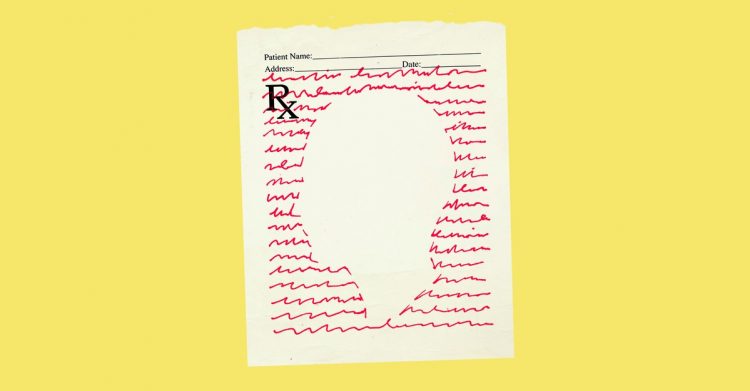You may not be aware of this, but you can read everything that your doctor writes about you. Go to your patient portal online, click around until you land on notes from your past visits, and read away. This is a recent development, and a big one. Previously, you always had the right to request your medical record from your care providers—an often expensive and sometimes fruitless process—but in April 2021, a new federal rule went into effect, mandating that patients have the legal right to freely and electronically access most kinds of notes written about them by their doctors.
If you’ve never heard of “open notes,” as this new law is informally called, you’re not the only one. Doctors say that the majority of their patients have no clue. (This certainly has been the case for all of the friends and family I’ve asked.) If you do know about the law, you likely know a lot about it. That’s typically because you’re a doctor—one who now has to navigate a new era of transparency in medicine—or you’re someone who knows a doctor, or you’re a patient who has become intricately familiar with this country’s health system for one reason or another.
When open notes went into effect, the change was lauded by advocates as part of a greater push toward patient autonomy and away from medical gatekeeping. Previously, hospitals could charge up to hundreds of dollars to release records, if they released them at all. Many doctors, meanwhile, have been far from thrilled about open notes. They’ve argued that this rule will introduce more challenges than benefits for both patients and themselves. At worst, some have fretted, the law will damage people’s trust of doctors and make everyone’s lives worse.
A year and a half in, however, open notes don’t seem to have done too much of anything. So far, they have neither revolutionized patient care nor sunk America’s medical establishment. Instead, doctors say, open notes have barely shifted the clinical experience at all. Few individual practitioners have been advertising the change, and few patients are seeking it out on their own. We’ve been left with a partially implemented system and a big unresolved question: How much, really, should you want to read what your doctor is writing about you?
The debate about open notes can be boiled down to a matter of practicality versus idealism. You’d be hard-pressed to find anyone, doctor or otherwise, who argues against transparency for patients in principle. At the same time, few people I spoke with for this article believe that the new rule has been put in place all that smoothly. For care providers, the primary concern has been the trouble that can come with writing notes for a new audience. Notes, generally scribbled in shorthand incomprehensible to the unknowing eye, have traditionally served doctors, and doctors alone. They allowed physicians to stay up to date on their patients and share information with colleagues for input on cases.
Some doctors told me they worry that open notes could result in distress for patients who read something they don’t understand, and that highly technical language could make something sound worse than it is. Oncology, for instance, can involve an onslaught of potentially concerning terminology. (Psychotherapy notes are exempt from the new rule.) Other doctors fear that valuable information can be lost if they go too far in de-jargonizing notes to make them patient-friendly. Or that de-jargonizing notes is simply unfeasible. “Let’s say you came to me with pain and pointed to your mid-clavicular line. I’d just put ‘MCL,’” says Aldo Peixoto, a nephrologist at Yale. “But if I were writing for you to understand, I’d have to say ‘pain on the top-right portion of her abdomen in the line that runs from the middle of her clavicle,’ and so on. Rather than writing four lines of prose, I could’ve used literally three letters.”
If that sounds quibbling, consider the trade-offs. Less time for doctors can translate into less time for patients. Many clinicians already write notes well into the evening. Certainly, the pandemic hasn’t helped. Some doctors told me that if they find themselves in a dilemma of either writing notes in less-efficient, plain language or fielding worried patient calls and messages, exhausted practitioners will face yet another burden. And then there’s the matter of trust. Jack Resneck, the president of the American Medical Association, the nation’s largest professional group of doctors and medical students, told me that doctors can need time and space with patients to get them to open up and be receptive to guidance through difficult situations. If these patients were to see notes too soon, Resneck said, they might “immediately flee and not come back to see you.”
As doctors have spent more time dealing with open notes, many have eased off their strongest objections. Some, including Resneck and the AMA, have warmed up to the new rule as certain exceptions have been granted, such as allowing doctors whose patients have parents or partners with access to their notes to omit certain details from their write-ups for privacy reasons. Other physicians seem to be coming to a somewhat awkward realization: On a practical level, many concerns about how this change affects patients are irrelevant, because most patients don’t yet know they have instant access to their notes in the first place. Every doctor I spoke with for this story told me that their patients were largely unaware. Many doctors and hospitals are not going out of their way to inform people about the new rule, so unless patients are particularly on top of shifting rules within our convoluted health-care system, they’re unlikely to encounter the notes on their own. Kerin Adelson, an oncologist at Yale, admitted she didn’t know how to find notes in her own patient portal. She spent several minutes with me on the phone fumbling through different tabs to locate them.
Fans of open notes are frustrated that there is not a greater push for awareness. Even acknowledging that the new system has its shortcomings, many argue that the only way to make things better is to get people invested in the access they’ve recently been granted. Lydia Dugdale, a primary-care doctor at Columbia University, worries about ensuring equity. “Things like socioeconomic status, education, literacy: All of those issues affect the degree to which any given patient is going to want to read and correct and interrogate his or her health record,” she told me. Tom Delbanco, a Harvard doctor and one of the co-founders of OpenNotes, an initiative that spearheaded the push for access to doctors’ notes in the U.S., believes that the effort required to refrain from using “bad words” in notes is minor, and that it shouldn’t make any significant demands on clinicians’ schedules. Doctors who are now taking more time to write notes because of the change, he told me, “probably ought to because they’ve been writing lousy notes.”
Open notes can be valuable for people with chronic conditions and their caregivers, who need to stay in the know. Liz Salmi, the communications and patient-initiatives director at OpenNotes, told me about pulling her full medical record eight years into dealing with brain cancer, before notes were easily and freely available. The document was 4,839 pages. To get a PDF, she said, she had to pay $15 for each DVD it was uploaded to, and her records spanned multiple discs. But the information was worth it: Having access to the record gave Salmi a way to remember all of the crucial bits of information she’d gotten piecemeal from various doctors.
The fact that many people have no idea open notes exist doesn’t change the deeply personal questions at stake in the debate about whether the notes do more good or harm—questions that everyone must confront in one way or another in dealing with America’s medical system, whether or not they fully realize it. How much information do you truly want about your health, and how much do you trust your doctor to deliver it to you? What is a doctor’s role in informing people about their health?
Open notes are only part of this conversation. The new law also requires that test results be made immediately available to patients, meaning that patients might see their health information before their physician does. Although this is fine for the majority of tests, problems arise when results are harbingers of more complex, or just bad, news. Doctors I spoke with shared that some of their patients have suffered trauma from learning about their melanoma or pancreatic cancer or their child’s leukemia from an electronic message in the middle of the night, with no doctor to call and talk through the seriousness of that result with. This was the case for Tara Daniels, a digital-marketing consultant who lives near Boston. She’s had leukemia three times, and learned about the third via a late-night notification from her patient portal. Daniels appreciates the convenience of open notes, which help her keep track of her interactions with various doctors. But, she told me, when it comes to instant results, “I still hold a lot of resentment over the fact that I found out from test results, that I had to figure it out myself, before my doctor was able to tell me.”
As Americans continue to age, get sick, and navigate the health-care system, many of us may become more invested in the idea of open notes. Until they play a more widespread role in people’s lives, however, the most pressing question about whether you truly want instant access to all your medical information might be how it affects your doctor’s life. Many physicians have come around to open notes, or at least have realized that allowing patients to see what has been written about them is not always a huge bother. But the bigger question of just how quickly patients should be able to access medical information, and how soon doctors should be available to help patients process it, continues to plague physicians. The advent of immediate data sharing “has been a major problem in terms of physician quality of life, and that’s eroded across the board,” Peixoto told me. “Doctors don’t want to be connected all the time. They actually have their lives.”
Where we have landed, then, is an in-between. Patients can read their doctor’s notes and view test results at any hour of the day, but we can access our providers only at certain times. There is likely room for refinement. Allowing a patient to select whether they receive test results from their physician or their portal, or see notes only after their doctor has had the opportunity to walk them through the terminology used, for instance, could make all the difference, some doctors told me. For now, it’s worth asking yourself whether you want to access your patient portal alone, or want to wait until you can get your doctor on the line.
Source by www.theatlantic.com


